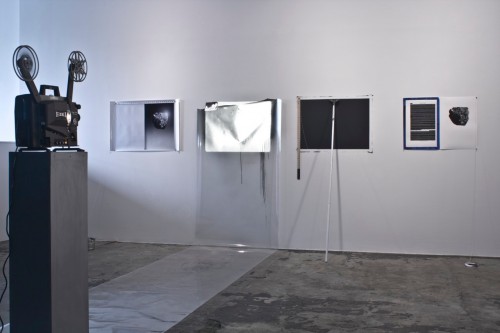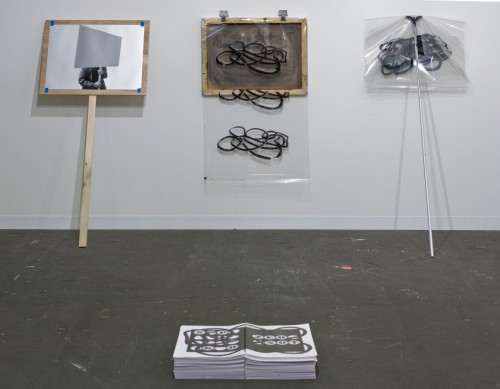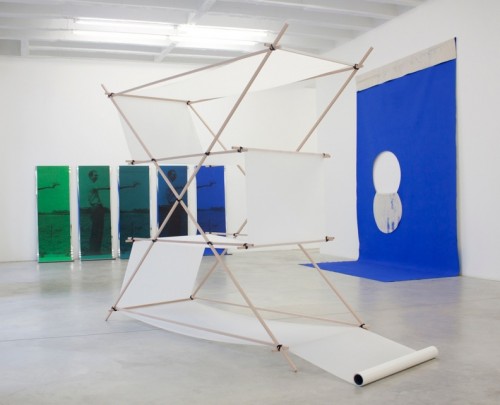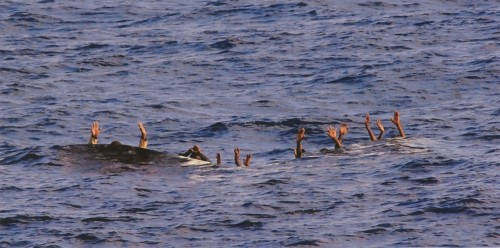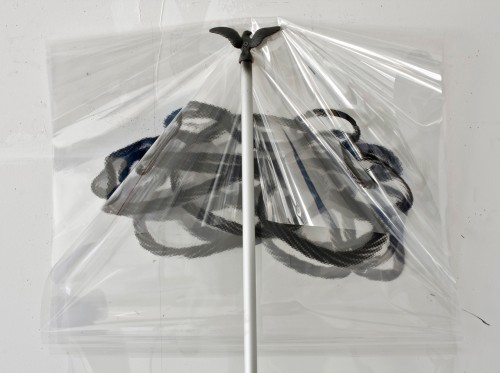Sreshta Rit Premnath’s over-arching project involves an investigation of scientific, philosophical, and aesthetic discourses in terms of the ways these discourses construct and dissemble our sense of the real. In Blue Book, Moon Rock, for instance, are arrayed multiple systems of measure and representation. One sees a sheet of paper on which is depicted a photograph of a moon-rock. Above the moon-rock is a measuring stick. In another document from the installation, one encounters a page from Wittgenstein’s “Blue Book” (one of the many philosophical journals the philosopher kept) entirely blacked-out except for the sentence: “We ought to talk further on about the meaning of ‘forgetting the meaning of the word.’” Following Wittgenstein, Premnath’s aesthetic universe provides his viewer with a vantage of the world from multiple “language games” (Wittgenstein’s term for particular modes of discourse), foregrounding the contradictions and dilemmas produced through this shifting vantage. (The journal Premnath has edited since 2006 appropriately enough is called Shifter, taking its name from linguist Roman Jakobson’s term for grammatical elements that help to establish a context for utterance, such as personal pronouns).
As if a limit point of this operation, in two other works, an artists’ book called Alif and an installation titled El Aleph, Premnath makes reference to Jorge Borges’ story “The Aleph,” of which the artist writes:
Borges imagined an unimaginable point in space, “El Aleph” – Infinity. A point which revealed everything all at once – everything in the universe from every angle simultaneously. But here we have a problem. What would a viewer actually “see” through such a point. In order to understand a script one must first learn it. That which is significant, is that which is decipherable. Viewers who encounter such a point in space would perhaps find themselves looking at a multiplicity of things and an infinity of noise.
By multiplying games of discourse and systems of representations, in the process Premnath touches on the epistemological, ontological, and practical limitations of our ability to reason and know. As I have written before at this blog and elsewhere, he is interested principally in constructing aesthetic objects in which we must question how language (and perhaps more importantly our uses of language) construct/s what can be known at any moment in history. In the absence of a totalizing perspective like the one described in Borges’ story, perhaps what we see instead are the blanks, blindspots, absences, and gaps; perceptual facts literalized repeatedly throughout Premnath’s work.
In Premnath’s work A Cage Went in Search of a Bird for instance, we see images of US war ships and helicopters surrounding Somalian pirates off the coast of Africa. The images of the war ships and helicopters are removed through digital manipulation, as if to sublimate the presence of US military power, or as the case may be make it appear through its “disappearance”–the pixelated outlines which trace its extraction. As Premnath puts it more eloquently:
The ocean is explored as territory that lies outside the realm of governmentality – a site of awe and threat. Day and night enormous quantities of cargo – the embodied process of the distribution of commodities – ply these waters silently, transparently. It is only at the moment of their disappearance that they suddenly become present to us all. Suddenly, when an oil tanker goes missing, its enormous body comes into focus. It is then that the cage goes in search of the bird. Law must be forced upon the lawless in order to make the absent present. In order to, once again, make the present disappear.
One witnesses these spectral residues also in a number of works exploring the status of monuments, especially in the series Horizon and Ekphrasis (Recto/Verso) (both from a 2010 show in Hong Kong titled “Spectral Evidence”). In Horizon, we see a series of images depicting monuments to Christopher Columbus, with a crucial element missing: the statues of Columbus that would otherwise rest on the plinths pictured in the photographs. Similarly Ekphrasis (Recto/Verso) depicts a series of monuments in Hong Kong that during WWII were melted down to produce weaponry.
If the aleph makes us picture a negation of sight that occurs through the simultaneous presence of too many perspectives, inversely Premnath’s work also presents us with a series of ciphers: those figures awaiting signification, meaning-making, desire, which appear ostensibly “blank.” In his work the cipher is a site of possibility in the imagination, or within said language games, where socio-political transformation, but also the potential for socio-political violence and cultural-historical displacement, would seem to co-exist. So we see in the installations Green Screen and Zero Knot forms of political gesture without content: a hand extended, or seemingly waving. Signage without slogans or demands also appear throughout Premnath’s work, an index of events yet-to-come, or as-yet-unresolved.
1. What is your background as an artist and how does this background inform and motivate your practice?
I grew up in Bangalore, India and began drawing and making things before I knew why. Over the years my reasons for making and the resultant strategies have changed but I remain mindful of that inexplicable impulse and the fact that it preceded my ability to reason.
In Bangalore I studied at a school that was built upon the educational philosophy of J. Krishnamurti. Some fundamental questions raised by him regarding the nature of subjectivity and reflexive procedures that can lead to a discovery of one’s ethical relations to other beings have had a lasting impact on me.
My mother is an ecologist who in collaboration with my father and others runs an organization in a very forested area close to Bangalore. The organization combines a seed-bank and reforestation program with an education and livelihood program for those communities subsisting from the forest. Their ecological concerns and strategies in combination with the demonstrated efficacy of education have provided a model of politics that is decidedly not anthropocentric and has certainly influenced my practice as an artist and teacher. Projects like Contraband (2008) and the more recent Rhizome (2011) are direct results of this influence.
The combination of these influences has brought about a productive friction in my practice between the inherent uncertainties that result from introspective inquiry and the necessary ethical imperatives of political and ecological thinking.
In 1998, after high school I moved to Cleveland to study art. There, for the first time I was made aware of my ethnicity as a factor in how I was identified. Since my inquiries regarding identity had until then been primarily ontological, the migration and resituation of my body politicized it in a way that I had not anticipated and forced me to simultaneously grapple with the ontic register of identification. This cultural discontinuity situated in my body and its habituated actions also brought to the surface of my attention an epistemological breakage – the histories that I did not know (whether “Indian,” “American” or otherwise) became starkly present in their absence. As such I began to feel uneasy making artwork that assumed any universalities of form as well as artwork that assumed any essentialities of subjectivity. I feel more and more that any ethics of making has to be situated in an attitude of unease and a logic of uncertainty – one that embraces self-doubt and skepticism but, I hasten to add, not at the cost of political paralysis.
While on the one hand I find the political clarity of Historical Materialism to be essential in thinking through social relations, I also find the more abstract and linguistic concerns of Analytical Philosophy crucial to my thinking. In fact my curatorial project On Certainty (2009), the installation Blue Book, Moon Rock and my most recent show Storeys End (2011) were all direct results of thinking through particular aspects of Ludwig Wittgenstein’s work and the legacy of analytical philosophy that continues to haunt conceptual strategies in art practice.
I therefore find it impossible to develop a homogenous practice that combines these three distinct yet entangled registers – namely the ontological, the ontic and the formal. Instead I work in a heterogeneous way, laying emphasis on different registers of this triad in each project within my art practice as well as in my other endeavors. While I find didactic strategies perfectly suitable in the classroom, I find them ineffective in artwork. While my art practice and the classroom may not be appropriate venues for amateur theoretical exegeses, Shifter, the magazine I founded in 2004 and continue to co-edit, serves as a perfect venue for such speculative thinking.
2. Do you feel there is a need for the work that you are doing given the larger field of visual art and the ways that aesthetic practices may be able to shape public space, civic responsibility, and political action? Why or why not?
No, I do not feel that there is a need for the work I do. Rather, to restate myself, I feel the need to do my work. If I respond to an external need, then it is the result of internalizing it, and once it is internalized it is felt as an impulse rather than a need. Although my sense of civic responsibility and my political motivations are reflected in my artwork, I do not see my artwork as a means of political action. Politics as a means of social change is fully grounded in the ontic register. It requires an ethical clarity and a contingent certainty. However, to apply Wittgenstein’s words on philosophy to art, “Lack of clarity in [art] is tormenting. It is felt as shameful. We feel: we do not know our way about where we should know our way about. And nevertheless it isn’t so. We can get along very well without… knowing our way about here.”
However, every human being is a political being and how we act in the world is the embodiment of our politics. Although in this sense all our actions in the world are political, they are in most cases not particularly good politics or effective politics. While we could expand the word art to include politics or conversely expand the notion of politics to talk about its aesthetics, I find the two categories to function in different modalities within my practice. When the political enters my artwork it becomes the ontic ground for various formal procedures as well as the concrete ground for philosophical speculation.
There are crucial political imperatives grounded in the ethical urgency of what ought to be done that cannot be effectively dealt with in my art practice. However, I don’t think this makes my artwork less important, rather it reveals that there are multiple modes of discourse and some are more effective in “shaping public space, civic responsibility, and political action” than others.
3. Are there other projects, people, and/or things that have inspired your work?
Here is a short list of disparate inspirations in no particular order:
- Edward Krasinski
- Roni Horn
- Bruce Nauman
- Béla Tarr’s “Werckmeister Harmonies” (as well as his recent “Man From London”)
- Harun Farocki’s “In Comparison”
- Jorge Luis Borges’ “Collected Fictions”
- Vilem Flusser’s “Towards a Philosophy of Photography”
- A K Ramanujam’s translations of Classical Tamil love poems from the 1st C BCE – 2nd C CE titled “Poems of Love and War”
- China Miéville’s, “The City & The City”
- David Harvey’s “Reading Marx’s Capital” classes at CUNY
- The music of N. Rajam, Vilayat Khan, Ghulam Mustafa Khan and Wasifuddin Dagar.
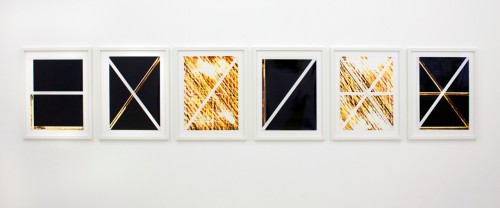
"EX / X," 2011. C-print scraped with bleach and blade. Series of 6 works, each 61 x 45.7 cm. Unique.
4. What have been your favorite projects to work on and why?
In the last two years I have worked on three important projects that continue to unfold: Zero Knot, at Art Statements in Art Basel, which dealt with the dialectical relationship of figures of power and figures of protest; Leo: procedures in search of an original index, at Gallery SKE in Bangalore, which dealt with the 2010 bankruptcy of MGM and the relationship between the symbolic and corporeal deaths of the MGM lion Leo and its spectral residue; and Storeys End at Galerie Nordenhake in Berlin, which focused on the death of Ludwig Wittgenstein and his early proclamation of the “death” of philosophy, followed by a “rebirth” of philosophy in his posthumously published writings.
Shifter, a magazine I founded eight years ago, is the longest continuous project I have worked on. It began as an online magazine, each issue gathering artwork, critical writing and experimental text around a specific topic and grew into a print publication with Shifter 10 : Transparent White. Following this I have co-edited each issue with close friends – Steven Lam, Kajsa Dahlberg, Jane Jin Kaisen, Avi Alpert, Abhishek Hazra, Warren Neidich and finally Matthew Metzger, who is now the coeditor of Shifter. These editorial collaborations have been especially meaningful to me over the years. Shifter also provides me with a platform to become closely acquainted with a diverse range of artists and writers, with some of whom I have maintained lasting relationships. Shifter has received Fiscal Sponsorship from NYFA this year and we hope to raise funds to offset at least some of the expenses we have borne personally, as well as expand the scope and activities of the magazine.
In regards to curatorial work, the exhibition and series of lectures titled On Certainty I curated at Bose Pacia in 2009 was memorable. With the generous support of Arani and Shumita Bose who ran a gallery for sixteen years in Chelsea and represented several significant artists from India, On Certainty combined my interests in art-making, critical theory and publishing in a non-hierarchical way, without having one mode explain or illustrate another. Once again it became a collaborative effort between the participating artists, speakers and myself forging lasting relationships with several people, most importantly yourself Thom.

"SUR&REN&DER," 2009-2011. Digital Composite Print, Chroma Key green paint, 18% gray paint, 47"x 240".
5. What projects would you like to work on in the future? What directions do you imagine taking your work in?
I was fortunate enough to receive a grant from the Art Matters Foundation this year to work on a project in Bangalore. The project focuses on the invisibility of labor in the utopian imaginary of “development.” When people talk about the urban development of Bangalore, one of the fastest growing cities in the world, the several hundred thousand laborers who actually build the city are left out of the discussion. I am interested in this ideological abstraction, which situates the expanding form of the city in the figure of the architect or developer rather than the construction worker. I will be in Bangalore from the end of this month until mid-January working on this project.
Apart from this, we are currently working on Shifter 18: Intention, which should be out in the beginning of February. This issue, which consists primarily of conversations and interviews between artists, scientists, activists and theorists including Sam Durant, Falke Pisano, Chris Sharp, Gregory Sholette, Hassan Khan, Machette Group, Hong-An Truong, Runo Lagomarsino and Olaf Nicolai to name just a few, has an incredible set of contributions and is definitely amongst the strongest issues of Shifter thus far. Dan Levenson, who designed Shifter 16: Pluripotential, will be designing the upcoming issue, which is something we are very excited about. The issue will also unravel with a group show organized by Gresham’s Ghost, Ajay Kurian’s roving curatorial project.

